Online Gather.town Pitches
Perfusion & Permeability I
Joint Annual Meeting ISMRM-ESMRMB & ISMRT 31st Annual Meeting • 07-12 May 2022 • London, UK

| Booth # | ||||
|---|---|---|---|---|
4604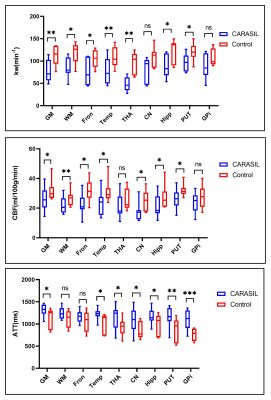 |
1 | Reduced Blood Brain Barrier Water Exchange and Cerebral Blood Flow in CARASIL Patients Revealed by Perfusion MRI: a pilot study Video Permission Withheld
Huiru Pan1,2, Yingying Li3, Huilou Liang1,2, Tingyan Yao4, Xingfeng Shao5, Xuejia Jia3, Zihao Zhang1,2,6, Zhentao Zuo1,2,6, Jing An7, Danny JJ Wang5, Rong Xue1,2,8, and Qi Yang3
1Institute of Biophysics, Chinese Academy of Sciences, Beijing, China, 2University of Chinese Academy of Sciences, Beijing, China, 3Department of Radiology, Beijing Chaoyang Hospital, Capital Medical University, Beijing, China, 4Department of Neurology, Xuanwu Hospital of Capital Medical University, National Clinical Research Center for Geriatric Diseases, Beijing, China, 5Mark & Mary Stevens Neuroimaging and Informatics Institute, Keck School of Medicine, University of Southern California, Los Angeles, CA, United States, 6The Innovation Center for Excellence in Brain Science and Intelligence Technology, Chinese Academy of Sciences, Beijing, China, 7Siemens Shenzhen Magnetic Resonance Ltd, Shenzhen, China, 8Beijing Institute for Brain Disorders, Beijing, China
We applied 3D diffusion-prepared pseudo-continuous arterial spin labeling (DP-pCASL) to evaluate water exchange rate (kw) of blood brain barrier (BBB) and its association with clinical characteristics of cerebral autosomal recessive arteriopathy with subcortical infarcts and leukoencephalopathy (CARASIL) patients. The CARASIL group showed significantly decreased kw and cerebral blood flow (CBF) compared with healthy controls. The association between kw with age, CBF and white matter hyperintensity volumes (WMH) found in CARASIL patients suggest that kw could be a potential non-contrast imaging biomarker for BBB dysfunction in cerebral small vessel disease.
|
||
4605 |
2 | A Hybrid-Two-Compartmental-Model for the Blood-Brain-Barrier Assessment of Glioma Patients
Dinil Sasi S1, Rakesh Kumar Gupta2, Rana Patir2, Suneeta Ahlawat2, and Anup Singh1,3
1Center for Biomedical Engineering, Indian Institute of Technology Delhi, New Delhi, India, 2Fortis Memorial Research Institute, Gurugram, India, 3All India Institute of Medical Sciences New Delhi, New Delhi, India Dynamic-contrast-enhanced (DCE)-MRI has shown wide potential in characterizing brain tumor. Conventionally, generalized-tracer-kinetic-model (GTKM) and Patlak-model (PM) have been widely used in clinics to characterize the blood-brain-barrier (BBB) integrity of the tumor. However, PM is recommended for DCE-MRI data with shorter duration (less than 1 minute) and GTKM may overfit in non-enhancing and normal tissues causing erroneous estimation of extra-vascular volume fraction (ve). So, the current study proposes a hybrid tissue depended model with maximum 2 model fitting parameters by combining GTKM and PM depending on underlying tissue. Proposed model has outperformed GTKM in all tissue regions. |
||
4606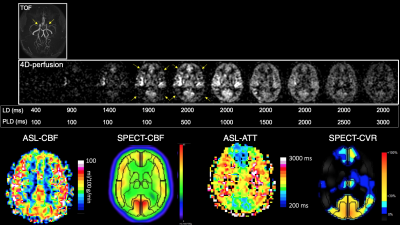 |
3 | Assessment of Cerebral Perfusion in Moyamoya Disease with Dynamic pCASL using a Variable-TR scheme with Optimized Background Suppression
Osamu Togao1, Makoto Obara2, Kazufumi Kikuchi3, Tatsuhiro Wada4, Chiaki Tokunaga4, Ryoji Mikayama4, Shingo Baba3, Marc Van Cauteren5, Akio Hiwatashi3, and Kousei Ishigami3
1Molecular Imaging and Diagnosis, Graduate School of Medical Sciences, Kyushu University, Fukuoka, Japan, 2Philips Japan, Tokyo, Japan, 3Radiology, Graduate School of Medical Sciences, Kyushu University, Fukuoka, Japan, 4Division of Radiology, Graduate School of Medical Sciences, Kyushu University, Fukuoka, Japan, 5Philips Healthcare, Tokyo, Japan
The aim of the present study was to determine whether the dynamic pCASL using a variable-TR scheme with optimized background suppression is useful for assessing cerebral perfusion in patients with Moyamoya disease by comparing with 123I-IMP SPECT. ASL dynamic data at 10 time points are acquired by changing the label duration and post label delay. Significant correlations were found between SPECT-CBF and ASL-CBF and between arterial transit time (ATT) and cerebrovascular reactivity (CVR) to acetazolamide challenge on SPECT. ATT was significantly longer in areas where the CVR was decreased than in areas where the CVR was maintained.
|
||
4607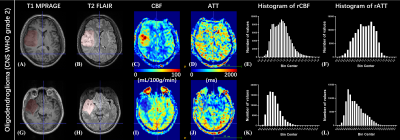 |
4 | Histogram-based analysis of perfusion features in oligodendrogliomas using multi-delay arterial spin labeling MR imaging: a preliminary study
Huilou Liang1,2, Lianwang Li3,4, Shengyu Fang3,4, Yinyan Wang3,4, Yuchao Liang3,4, Zeshan Yao5, Jing An6, Yan Zhuo1,2,7, Lei Wang3,4, Lijuan Zhang8, Danny JJ Wang9, and Rong Xue1,2,10
1State Key Laboratory of Brain and Cognitive Science, Beijing MRI Center for Brain Research, Institute of Biophysics, Chinese Academy of Sciences, Beijing, China, 2University of Chinese Academy of Sciences, Beijing, China, 3Beijing Neurosurgical Institute, Beijing, China, 4Department of Neurosurgery, Beijing Tiantan Hospital, Beijing, China, 5AnImage Tech. Beijing Co., Ltd., Beijing, China, 6Siemens Shenzhen Magnetic Resonance Ltd, Shenzhen, China, 7CAS Center for Excellence in Brain Science and Intelligence Technology, Chinese Academy of Sciences, Beijing, China, 8Shenzhen Institutes of Advanced Technology, Chinese Academy of Sciences, Shenzhen, China, 9Laboratory of FMRI Technology (LOFT), Mark & Mary Stevens Neuroimaging and Informatics Institute, Keck School of Medicine, University of Southern California, Los Angeles, CA, United States, 10Beijing Institute for Brain Disorders, Beijing, China
The clinical treatment and prognosis of oligodendrogliomas are closely related to the histopathological grade. As a non-invasive and non-contrast perfusion imaging technique, arterial spin labeling (ASL) has been widely used in studies of glioma grading. The estimation of cerebral blood flow (CBF) in conventional single-delay ASL can be affected by the arterial transit time (ATT) effect. Here, multi-delay 3D ASL providing multiple hemodynamic parameters including ATT and ATT-corrected CBF was used to analyze the histogram-based perfusion features in oligodendrogliomas. Our results showed no difference in rCBF between WHO grade 2 and 3 oligodendrogliomas, but prolonged rATT in higher grade oligodendrogliomas.
|
||
4608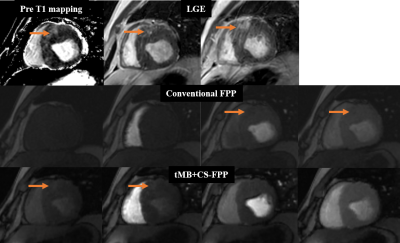 |
5 | Auto-calibrated Mutiband First-pass Perfusion Imaging with CS reconstruction in patients with suspect CAD at 3T MRI
Lixian Zou1,2, Jialing Chen3, Yuan Zheng4, Yu Ding4, Yubao Liu3, Jian Xu4, Hairong Zheng1,2, and Xin Liu1,2
1Paul C. Lauterbur Research Centre for Biomedical Imaging, Shenzhen Institutes of Advanced Technology, Chinese Academy of Science, Shenzhen, China, 2Shenzhen College of Advanced Technology, University of Chinese Academy of Sciences, Shenzhen, China, 3Medical Imaging Center, Shenzhen Hospital, Southern Medical University, Shenzhen, China, 4UIH America Inc., Houston, TX, United States
A whole heart perfusion imaging with auto-calibrated multiband CAIPIRINHA with through-time encoding and iterative reconstruction (tMB+CS-FPP) has been proposed to acquire multiple slices simultaneously without extra reference scans. The technique can achieve perfusion images with doubled anatomic coverage with identical spatial resolution. In this study, we compared the performance of the tMB+CS-FPP using different k-t undersampling patterns in a phantom study. And the proposed method was performed to the patients with suspect CAD and was compared to the conventional FPP.
|
||
4609 |
6 | Towards clinical perfusion imaging at 5T using 3D ASL
Yan Tong1, Qing Wei2, and Jun Xie2
1Shenzhen United Imaging Research Institute of Innovative Medical Equipment Innovation Research, Shenzhen, China, 2United Imaging Healthcare, Shanghai, China
Arterial spin labeling (ASL) benefits from both increased intrinsic SNR and reduced T1 relaxation time at higher field strength. However, the implementation of ASL at 7T is challenging, primarily due to increased SAR, and B1+/B0 inhomogeneity. Recently, United Imaging Healthcare introduced a 5T whole-body scanner. 5T might be a superior field strength for ASL due to the improved SNR compared to 3T, and less severe B1+/B0 inhomogeneity and reduced SAR compared to 7T. This study demonstrated the feasibility of high-resolution ASL at 5T, and the results showed superior SNR compared to 3T.
|
||
4610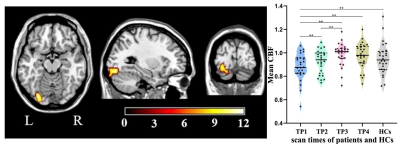 |
7 | Altered dynamic cerebral perfusion during recovery in right hemisphere subcortical stroke
Peifang Miao1, Caihong Wang1, Ying Wei1, Jingliang Cheng1, and Kaiyu Wang2
1The First Affiliated Hospital of Zhengzhou University, Zhengzhou, China, 2GE Healthcare MR Research, Beijing, China, Beijing, China
To quantify cerebral blood flow (CBF) dynamic evolution and the relationship with clinical outcomes during recovery in right subcortical stroke patients,ASL and neurological examinations were performed repeatedly in 25 patients at 4 time points and 26 healthy controls (HCs) once.One-way Within-Subjects ANOVA and two sample test,pearson correlation analyses were performed.Compared with HCs, patients displayed continuous crossed cerebellar diaschisis.Increased CBF of contralesional sensorimotor cortex in the subacute and chronic are vital for recovery.Patients showed dynamic changes of CBF in contralesional cerebellum superior and occipital lobe,which were negatively correlated with memory.Findings provide a theoretical basis for functional impairment and recovery after stroke.
|
||
4611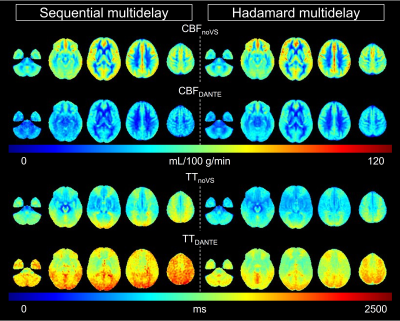 |
8 | Effects of vascular territories on the efficiency of DANTE preparation pulse for ASL
Shota Ishida1, Hirohiko Kimura2, Naoyuki Takei3, Yasuhiro Fujiwara4, Tsuyoshi Matsuda5, and Nobuyuki Kosaka2
1Department of Radiological Technology, Faculty of medical sciences, Kyoto College of Medical Science, Nantan, Japan, 2Department of Radiology, Faculty of Medical Sciences, University of Fukui, Eiheiji, Japan, 3GE Healthcare, Tokyo, Japan, 4Department of Medical Image Sciences, Faculty of Life Sciences, Kumamoto University, Kumamoto, Japan, 5Division of Ultra-high Field MRI, Institute for Biomedical Science, Iwate Medical University, Shiwa-gun, Japan
This study aimed to assess whether the efficiency of DANTE, a vascular suppression in ASL, is affected by vascular territories. CBF, transit times (TT), and their rates of change were determined in nine vascular territories from the proximal to distal regions. Although CBF reduction rates were not different among the territories, TT extension rates were lower in the distal region than in other regions. No correlation was observed between TT extension and CBF reduction rates. DANTE efficiency is not affected by transit time or vascular territories. Homogenous vascular suppression effects could be obtained by DANTE-ASL.
|
||
4612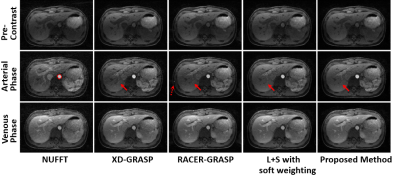 |
9 | Improved Dynamic contrast in Motion Corrected Dynamic Contrast Enhancement MRI Using Low Rank with Soft Weighting and Joint sparsity
Jichang Zhang1, Xinpei Wang1, Faisal Najeeb2, Pengfei Xu1, Hammad Omer2, Penny Gowland3, Sue Francis3, Paul Glover3, Richard Bowtell3, and Chengbo Wang1
1SPMIC, The University of Nottingham Ningbo China, Ningbo, China, 2COMSATS University Islamabad, Islamabad, Pakistan, 3SPMIC, The University of Nottingham, Nottingham, United Kingdom This work presents a motion corrected free breathing Dynamic Contrast Enhanced MRI (DCE-MRI) with improved dynamic contrast reconstruction method called L+S with soft weighting and joint sparsity. Soft weighting achieves accurate motion correction at expense of dynamic contrast. An additional temporal Fast Fourier Transform (FFT) constraint is used to recover the dynamic contrast. A simulated phantom dataset was created with ground truth in this work, enabling quantification of the motion correction and dynamic contrast performance. The proposed method achieved improved dynamic contrast, better motion correction and high reconstruction efficiency simultaneously. |
||
| 4613 | 10 | Evaluate myocardial microcirculation in pediatric myocarditis patients with free breathing intravoxel incoherent motion MR sequence
Shilan Li1, Jiahuan Tao1, Jing Zhang1, and Kai Ai2
1Department of Magnetic Resonance, Lanzhou University Second Hospital, Lanzhou, China, 2Philips Healthcare, Xi’an, China
To explore the possibility of application of free breathing intravoxel incoherent motion (IVIM) imaging in pediatric myocarditis patients, we utilized diaphragmatic navigation technique to detect heart rate and improved the probability of scanning success. Eight pediatric myocarditis patients and ten healthy volunteers were enrolled. The study confirmed that the IVIM imaging method with free breathing condition was acceptable and achievable. Besides, compared with healthy children, the microcirculation of myocarditis patients was impaired, and pseudo-diffusion coefficient (Dfast) and perfusion fraction (f) were significantly lower.
|
||
4614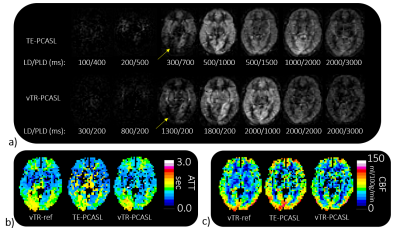 |
11 | Comparison of time-encoded and sequential variable-TR scheme for multi-delay pseudo-continuous arterial spin labeling
Makoto Obara1, Osamu Togao2, Lena Vaclavu3, Tatsuhiro Wada4, Chiaki Tokunaga4, Ryoji Mikayama4, Hiroshi Hamano1, Matthias van Osch3, Kim van de Ven5, and Marc Van Cauteren6
1Philips Japan, Tokyo, Japan, 2Department of Molecular Imaging and Diagnosis, Graduate School of Medical Sciences,, Kyushu University, Fukuoka, Japan, 3C.J. Gorter center for high field MRI, department of Radiology,, Leiden University Medical Center, Leiden, Netherlands, 4Division of Radiology, Department of Medical Technology,, Kyushu University Hospital, Fukuoka, Japan, 5Philips Healthcare, Best, Netherlands, 6Philips Healthcare, Tokyo, Japan
There are two approaches proposed to calculate cerebral blood flow (CBF) and arterial transit time (ATT) accurately, while ensuring sufficient SNR. One is time-encoded (TE) and the other is sequential variable-TR (vTR) pseudo-continuous arterial spin labeling (PCASL). In this study, we measured SNR, CBF, and ATT from these two methods and compared and verified their validity in 5 healthy subjects. The higher SNR was secured in TE-PCASL compared to vTR-PCASL. On the other hand, ATT calculated from vTR-PCASL showed higher correlation coefficient with reference compared with TE-PCASL. The CBF calculated from both schemes showed high correlation coefficient with reference.
|
||
The International Society for Magnetic Resonance in Medicine is accredited by the Accreditation Council for Continuing Medical Education to provide continuing medical education for physicians.